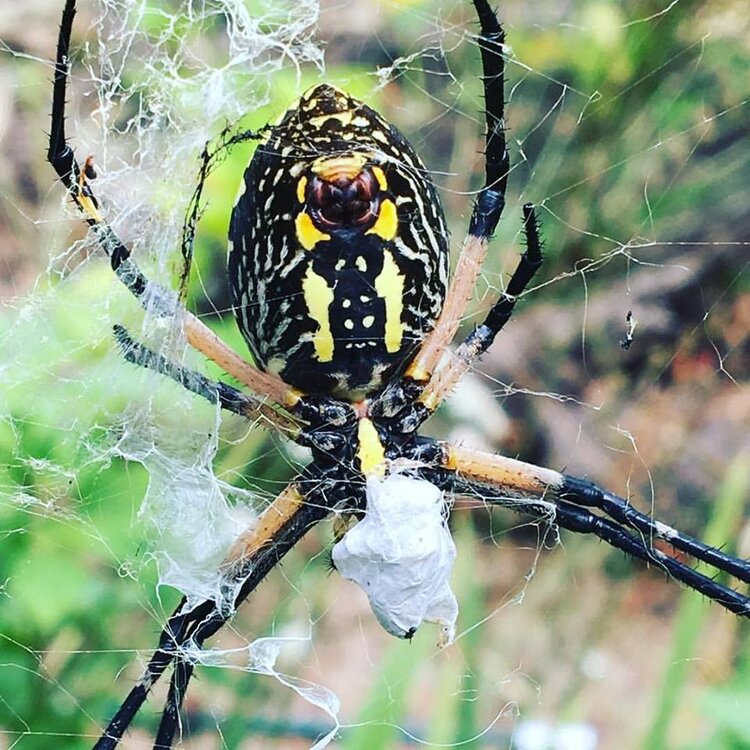“Before you get the napalm out, let me take a moment and explain why you should just let Spidey hang out. ”
What is it about just the very thought of spiders that makes our skin crawl? Just imagining their many little legs scurrying along is the stuff of nightmares for many. And the bigger they are, the more terrifying they are.
Which means that many of you would rather burn your house down than let an Argiope aurantia take up residence.
Don't know which spider I'm talking about? You've probably seen the large, lanky Yellow Garden Spider lurking around your yard in the mid to late summer. In fact, her large size and bright (dare I say beautiful) golden color make her hard to miss.
What? That thing is living in my garden? You may have just shrieked and run for your blow torch. But before you get the napalm out, let me take a moment and explain why you should just let Spidey hang out.
Yellow Garden Spiders are large, orb-weaving spiders, which means they weave circular webs. They have a vast territory and can be found all throughout the United States, Canada, Mexico, and Central America. Female spiders average between 0.75 and 1.1 inches in length, while males tend to only be about a third of that size. The big (dare I say beautiful again) ones you see are the females, with black coloring on the tops of their abdomens decorated with symmetrical patches of bright yellow. Towards the abdomen, the legs are reddish-brown and black towards the ends. Male spiders look similar, with brown all over their legs and much less yellow.
“While they don’t write words, Yellow Garden Spiders weave a complex zig-zag pattern into their webs. They even have an additional claw on each foot to help them in their web-weaving activities. (While most spiders have two claws per feet, the Yellow Garden Spider has three.)”
Which means, yes, they can likely be found living in your garden. But that’s actually a good thing, especially if you are a fan of tending to and caring for plants. Yellow Garden Spiders catch and eat insects in their web-many of which are pests that would happily munch away at your plants.
Yellow Garden spiders are also real-life Charlottes (you know, from Charlotte's Web. I hope I didn't lose you there). While they don’t write words, Yellow Garden Spiders weave a complex zig-zag pattern into their webs. They even have an additional claw on each foot to help them in their web-weaving activities. (While most spiders have two claws per feet, the Yellow Garden Spider has three.)
These patterns are called stabilimenta (or stabilimentum for an individual pattern). Producing silk for webs is a huge metabolic drain on spiders, which leads scientists to believe that stabilimentum surely must serve some purpose, but no one knows quite what that purpose is. Initially, scientists believed that stabilimenta served to give the webs stability (thus the name), but it's more accepted today that its purpose is to either increase or decrease web visibility, attract prey or a mate, or simply be a means to use up excess silk.
Interestingly, these spiders actually eat the central portions of their webs each night, allowing them to reabsorb the proteins in the silk back into their bodies and create more the next morning. They may also take in nutrients from tiny bits of insect stuck to the web.
At the end of summer, females produce three to four eggs sacs containing 300-1,400 eggs. The sacs look similar to paper bags and females will weave them into their webs to keep them safe over the winter. Each sac can release up to 1,000 spiderlings, but most won't survive into adulthood.
Yellow Garden Spiders are venomous, but they are unlikely to bite unless they are provoked. If you grab one protecting its egg sac, it will bite, but the result in humans is little worse than a wasp sting. The venom is used to paralyze prey and also predigests its prey's insides.
While they may not be as useful in your yard as say, an opossum, the Yellow Garden Spider is unlikely to cause any harm. So maybe you should give Charlotte a break before you burn her web down.

